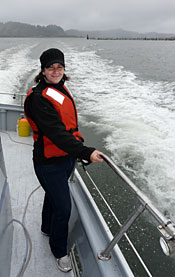You are here
Teacher Transforms Environmental Research into Curriculum for Students
08/03/09 Portland, Ore.  Kelly aboard the Sea Breeze heading to a sampling site in the Columbia River Estuary.
Kelly aboard the Sea Breeze heading to a sampling site in the Columbia River Estuary.
When she applied to CMOP's teachers program, Stephanie Kelley, a high school science teacher in Portland, Oregon, hoped to experience coastal margin research firsthand. After spending time in the field and the lab, she gained a better understanding of how scientists collect and utilize data. Kelley spent five weeks this summer learning about river-to-ocean science as an intern in the Teachers Translating Research into Practice internship program at the Center for Coastal Margin Observation & Prediction (CMOP).
“As a science teacher, I think it is important to keep expanding your knowledge,” Kelley says. “CMOP gave me greater exposure to the science and technology used to study the Columbia River estuary.
Kelley spent part of her internship gathering information from CMOP’s observation network and transforming it into curriculum for her high school students. One of the “units” will focus on the biology of the Columbia River. She plans on using the data from CMOP research cruises and glider missions to give her students a better understanding of how the biology and chemistry interact in the river, estuary, and near plume.
Another unit will be a scientific introduction to the physical properties of the Columbia River, estuary, and near plume. What is an estuary? Why are we studying the estuary? Why do we need to protect them? She will use the real-time data from SATURN endurance stations to give students a basic understanding of the characteristics of the estuary.
 "It has been great to watch Stephanie learn about the research objectives and practices at CMOP and see how she can develop curriculum that allows her students to learn about cutting-edge science, with the placed-based orientation of using the Columbia River as the foundation for her activities," says Karen Wegner, director of K-12 education.
"It has been great to watch Stephanie learn about the research objectives and practices at CMOP and see how she can develop curriculum that allows her students to learn about cutting-edge science, with the placed-based orientation of using the Columbia River as the foundation for her activities," says Karen Wegner, director of K-12 education.
Kelley is a science instructor at the Native American Youth Association (NAYA) Early College Academy in Portland, Oregon. In fact, she is the only science teacher at the Academy that is comprised of Native American students from around the country. Kelley, who herself is part Shoshone, wants to provide her students with insight into the latest scientific information and technology.
“Part of the reason I teach science at NAYA is to ensure that young Native American students have all the same opportunities as other students around the country,” Kelley says. “On reservations, they have to manage their own natural resources. It would be great if more people from their own tribe could have the scientific knowledge to help them be self sufficient in managing their own resources.”
When Kelley returns to the classroom, she will bring a wealth of knowledge gained from her summer internship. By exposing students to the curriculum she created from CMOP’s scientific data and information, she believes it will help her students gain an advantage when heading off to college or the workplace.
Written by Jeff Schilling






